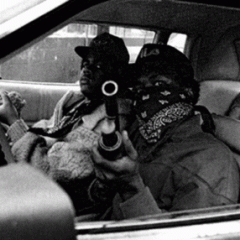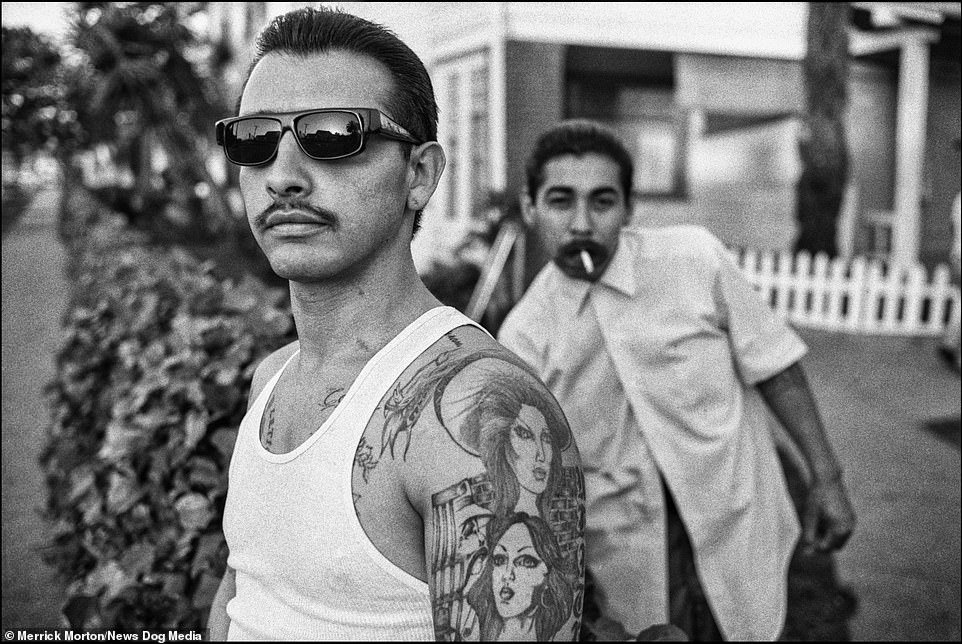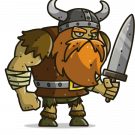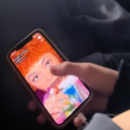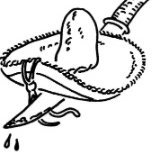Search the Community
Showing results for tags 'sureño'.
-
This thread will follow the development of the shotcaller of Toonerville Rifa, better known by his street name, Chorizo
-
First, I would like to mention that this is not my guide, this guide was originally made by Liam (@Large Hazard) and with his permission, it is being converted and used for GTA: W, small changes have been made and might occur down the line. The Sureño Car In jail/prison, a 'car’ is any selection of inmates who group together for the purposes of socialization, protection, and often a criminal enterprise. The prison system on GTA: W is heavily based on the California system, which is perhaps the most segregated system in the United States. Inmates in this system self-segregate by race and almost never cross racial lines except in matters of business or prison politics. The cars in this system are thus racial cars. The main cars are as follows: Black car: All African-American inmates regardless of affiliation. Subdivides based on those affiliations/cards (Crip, Blood etc.). Organization provided by gangs such as KUMI and the Black Guerrilla Family in some institutions, not usually in county jail. In LS county, Black inmates will subdivide based on neighborhood/neighborhood card (Blood, Hustler Crip, Mafia Crip etc.). White car: All White inmates. Subdivides based on geographical origin (city in prison, area in LS county) and sometimes affiliation (e.g. skinheads often have their own car). Organization provided by gangs such as Public Enemy No. 1, Nazi Lowriders, Family Affiliated Irish Mafia, Aryan Brotherhood etc. Asian/Pacific Islander car: All Asian and Asiatic inmates (includes Arabs etc.) plus Pacific Islanders. It can function as an 'Other’ car. Organization varies heavily from facility to facility. Norteño car: All Hispanic inmates from Northern San Andreas, more specifically often just Norteño gangs as Sureño gangs push north. Subdivides based on geography if numbers permit, acts as one car if not. Organization provided by the Northern Structure (Nuestra Raza) and Nuestra Familia gangs. NOT PRESENT in LS County. Sureño car: The Sureño car is obviously the primary focus here, others were explained for context. The Sureño car includes all Hispanic inmates from Southern San Andreas plus Sureño gang members from the frontier gangs in the north. Also affiliated are Armenian inmates who identify with the AP13 gang. Inmates of other races (White, Asian, and even Black) are accepted if they are Sureño gang members. In LS County, the Sureño car is really just the Mexican car as there is no Northern car. All American-Hispanic inmates belong to the one car. The Sureño car subdivides based on geographic origin in most institutions, as the car almost always has significant numbers owing to the huge Sureño gang population (estimated at well over 100,000 statewide). Major geographical subdivisions include parts of Los Santos: West Los: Vespucci, Del Perro, La Puerta, Little Seoul, Pillbox Hill, West Vinewood. North Side: East Vinewood, Hawick, Mirror Park. South Side: Rancho, Davis, Strawberry, Chamberlain Heights. East Los: El Burro Heights, Murietta Heights. Rural/suburban parts of the county (‘the valley’) would also have their own car though we’re unlikely to see many characters from there. In Los Santos, the larger varrios (‘super gangs’ like Florencia) may even have enough members in jail to support their own car independently. We are unlikely to be able to RP this, however. Cars within the Sureño car are not official subdivisions as in other racial cars. Each area does not have a rep, though there may be senior members. Instead, they are simply more like social cliques. Sureños will socialize and work out with others from similar areas, as they have more in common. Internal car politics may also be present. In terms of official car structuring, the Sureño car uses the Mesa system. The entire Sureño world is dominated by the Mexican Mafia (aka the Eme), a prison gang formed in the 1950s which now controls organized crime in huge portions of the state and controls the Sureño car in every prison and county jail. The Eme itself comprises only a couple hundred members and has a completely horizontal structure with no formal ranks. When Emeros began to be locked down in permanent segregated housing, the Mesa system was constructed to allow control of Sureño activities to continue through intermediaries. Each yard is run by a collection of senior inmates who make up the Mesa ('table’). The Mesa makes collective decisions on politics and some business. The Mesa answers to the Mexican Mafia directly in some way. If Emeros are present in the same facility, the Mesa answers to every member present. Unofficially however, each Emero has varying degrees of influence over a given Mesa and it may be possible for a single carnal (member, literally 'brother’) to dominate the entire Mesas. If Emeros are not present in the same facility, the Mesa still answers to somebody, possibly a carnal in another facility. Much internal Mexican Mafia politics and feuding result from the struggle to control Mesas. Members of each Mesa are often appointed directly from a carnal's associates or homeboys. A hostile takeover, similar to how most other cars determine leadership, is possible however all authority still flows from the Mexican Mafia. If a Sureño attempts to murder his way into the Mesa without backing or approval, he may be killed or forced off the yard in turn on orders from the Eme. The Mesa system comprises a complex structure, far more organized than the Eme’s horizontal layout. Essentially every possible custodial subdivision has an associated representative ('rep’), placed in a structured hierarchy. A full structure includes: Several representatives overseeing the whole yard (the Mesa itself) A rep for each building on the yard A rep for each unit in a building A rep for each tier in a unit A rep for each cell on a tier For us, roleplaying in this specific county jail, our modified structure will likely be set out as follows: Eme (carnal or carnales in the facility, probably laying low and running things subtly) ‘Pod boss’ in each unit: if each pod is active and has a rep each, these two pod bosses plus the carnales in the jail will more or less make up the Mesa Tier rep on each tier, reporting to their pod boss Cell rep in each cell, reporting to their tier rep. - A cell is considered an individual unit of the car, thus cell reps are utilized to maintain maximum organization. A tier rep will always communicate with a cell’s representative if there are orders to be given for both occupants of the cell, or if the cell has a problem. Non-cell reps will communicate with the rep for their tier through their cell rep. This may seem like an extra layer of added bureaucracy but it’s done in real life to maximize organization and militancy. We should do the same. Each rep answers to their respective superior in the chain and is delegated tasks as such, allowing for a compartmentalized car structure which facilitates effective organization of large numbers of Sureños and delegation of important administrative tasks. Such tasks include assembling roll call lists ('gallos’), organizing hits, monitoring Sureños for battle-readiness, collecting intelligence, and overseeing the following of reglas (rules) and workout programs. The above full structure is designed to handle numbers of around 100-150, an average maximum number of Sureños on a state yard. The numbers on GTA:W are obviously much lower and we are roleplaying with a modified county jail structure, so fewer positions are utilized. The tasks and duties of each position remain the same, however, and each position may take up more duties to compensate for the ranks which have been omitted. A separate ‘para-Mesa’ structure also often exists in facilities with Mexican Mafia members directly present. The Mesa runs the day-to-day politics of the yard while an Emero's personal crew handles his business directly. This includes running his own personal business enterprises and protecting his interests (e.g. organizing and overseeing 'personals’, i.e hits ordered directly by him). The crew may exist parallel and separate to the Mesa, or it may include members of the Mesa structure. Usually, it's a combination of both. Stacking a yard’s Mesa with one’s own crew members is a common tactic employed to ensure total domination over a yard. If the Mesa and the crew are not the same, the Mesa will usually have authority over common political matters which the crew will not, but the Mesa will not be permitted to interfere with the crew’s business. This is considered ‘fucking with (a member’s) money’ and is usually a death sentence. The Sureño car is officially allied with the White car in every facility statewide, owing to a longstanding alliance between the Aryan Brotherhood and Mexican Mafia which is over 50 years old. In some yards, this alliance may only be nominal, as business and political issues can result in hostility and even open war between the two. The allied relationship is still the default however, and any yard with hostile White and Sureño cars is considered exceptional, even if there are multiple at any given time. Hostilities between the two are often forced to an end eventually by the Mexican Mafia and Aryan Brotherhood, as joint business ventures (which are somewhat common) are jeopardized by war. The White/Sureño relationship results in some contact across racial lines, but still only in matters of business or politics. Whites and Sureños will often share gym equipment, phones, and televisions (but use them separately), though keep separate tables. The two groups will also often work out together behind closed doors (in locked-down units or segregation units) but will not usually work out together on open units or yards. The only instance in which the two groups will regularly work out as one, in the same space, is on group SHU and death row yards. The AB/Eme alliance prompted a mirror alliance between the Black Guerrilla Family (BGF) and Nuestra Familia, allying the Black and Norteño cars in the same way and in opposition to the Whites and Sureños. This alliance is somewhat less stable due to the declining influence of the BGF. Ultimately, relations between cars are fluid and change from facility to facility and over time. The Sureño car is typically highly regimental regarding battle-readiness and internal rules (reglas). The Sureño car is among those who ‘hit chomos on sight’, meaning paperwork of all newly transferred inmate is checked to verify they have no sex crimes on their jacket. Rapists are to be stabbed once proof of their status has been obtained, and could be produced when questioned about the motive behind the stabbing. The Mexican Mafia The Mexican Mafia operates on the basis of a horizontal structure. The only rank is that of a full member (“brother”/”carnal”). In other words, you are simply in the Mexican Mafia or you are not. There is no formal differentiation or seniority between members. Every member is of equal status with every other member, and every member is entitled to a vote of equal value on important matters or the candidacy of a prospective member. One negative vote from one member is considered sufficient to reject a new member. In reality the idea of equal status is, in many cases, simply theoretical. Older or more senior members accumulate massive amounts of influence over their decades’ long careers and often end up leading a faction inside the organization. Members of these factions only consider other members of the same faction allies. All other Carnales are potential enemies. In-fighting between factions and individual members can result in extensive gang wars. Conflict rarely occurs between a Mexican Mafia member and an external force (a non-Mexican Mafia group or individual). Most varrios in southern California pay tax and few independent drug dealers refuse to do so. The majority of conflict occurs internally, usually over territorial disputes. Secure Housing Unit (SHU) Roleplay Roleplay in the Secure Housing Unit (SHU) is an incredibly important part of the big picture. Sureño cars are traditionally "run from the back", meaning the leadership structures on general population yards (usually Mesas) defer authority to "big homies" in the SHU, either actively or passively. This means the Sureños who run the SHU program also have the authority to run the mainline yards. "Actively" meaning the yards take direct orders, "passively" meaning those in the SHU do not actively interfere in mainline affairs or give many direct orders but their authority is technically recognized and their orders will likely be followed if they give them. If there are Mexican Mafia members in the facility (usually in the SHU), they will definitely run the mainline yards actively. Non-Mexican Mafia residents of the SHU may also run things actively if they are still considered quite senior. If they are not especially senior, they probably run yards passively. Most racial cars use this system, as whoever is running the SHU program is probably an experienced and respected inmate even if they do not have the backing of a gang (e.g. the Mexican Mafia). It is also simply convenient to have the entire facility run from the SHU, as the SHU can easily act as a conduit of communication between all yards. Every facility only has one SHU building and inmates from all yards are sent there, so whoever is running the SHU is capable of sending and receiving messages to and from all yards. What is the relevance of all this? Roleplaying in the SHU means roleplaying with (probably) the most senior inmates in the facility. On GTA:W, this means roleplaying with the Mexican Mafia directly. SHU roleplay is also important to learn about as you will inevitably be sent to the SHU in the natural course of your prison roleplay. Possession charges, assault charges and riot charges - all quite common - usually result in SHU time. Another point worth mentioning is that a lot of prison roleplayers find SHU roleplay quite fun, as it is a change of pace from regular prison roleplay, and so nailing the basics down will ensure you do enjoy the experience. First days in the SHU are similar to the first days in general population. Your character will be contacted by whomever is running the program, asked for their "papers" (lockdown chrono which lists their charge(s)) and for their "plug". A plug is a kite written by whomever runs the mainline program explaining the circumstances and why your character is now in the SHU. If the incident was unplanned, the veracity of your character's claims will be established in another way. This background information is assessed in order to determine whether or not the new arrival is there on 'legitimate' charges. Things like taking off on enemies without authorization or carrying out a murder (or attempted murder) without authorization are not legitimate charges and will see the inmate punished by those in the SHU for breaking reglas. The new arrival may also be asked if they need anything (food, coffee, books etc.) and will be filled in on SHU program rules if necessary. The method by which inmates communicate in the SHU (and in lockdowns) will be covered in the next section. SHU program specifics will not be covered here, as they should be learned IC. There are a few points worth mentioning, however. Roleplaying in the SHU requires quite a different mindset. If your character is not an experienced convict or is new to the SHU, you should roleplay as you did during your first days in prison. The SHU is a step up - everything is more serious and intense. The most hardcore individuals from every race are represented in the SHU and it is their territory in which your character now finds himself. Minor mistakes or breaches of protocol will mandate punishment - usually by the victim's cellmate as there is nobody else with access to him. Antagonizing members of other races or even simply being loud will also mandate punishment. Repeated offences may get an inmate killed. The older, more serious inmates in the SHU appreciate a quiet and respectful environment. An inmate making a fool of himself may find a kite is sent to his cellmate with a knife attached. The bottom line here is that you should roleplay carefully and that it is important to take into account the nervousness your character is sure to be experiencing. For the sake of realism, long term SHU roleplayers are unlikely to be forgiving of mistakes. In order to roleplay those characters properly, a measure of ruthlessness is required. Keeping this in mind will help you avoid getting your character into trouble, allowing you to adapt to the SHU environment and enjoy the roleplay on offer there. Communication Between Cells (Kites and Similar) Convict ingenuity means even being locked behind a steel door has proven inadequate for putting a stop to communication. During lockdowns, non-program hours and in the SHU, the most common method of communication is by "kite" ('huila'). A kite is a letter written on a small piece of paper, usually in microscript ('micro-writing') in order to fit as much text as possible on a small form. The contents of a kite may be about any given subject. Many are innocent conversations between inmates about mundane topics, such as trading commissary or lending books. This is because the Sureño car is one of the racial cars which regulates the way its members communicate. Shouting in the unit is forbidden unless necessary, so the use of kites is the only way inmates can have any kind of conversation between cells. Some inmates play games such as tic-tac-toe with kites. On the other hand, kites are frequently used for serious matters such as giving orders and discussing prison politics. Disputes between cars may be solved by kite and orders to kill or riot may also be transmitted by kite. Exhibition of respect is of paramount importance in prison and this is reflected in kites. There are certain customs every inmate follows when writing kites, and each car has its own exclusive customs as well. A kite will commonly be opened with allusions to "love and respect" for the recipient. The closing lines of kites follow the same principles. Between Sureños the standard opening is "saludos y respetos" ("salutations and respects"), shortened to "SYR" or "S/Y/R". The standard closing is a variation of "con respeto" ("with respect") - such as "con todo respeto" ("with all/total respect") or "con sentido respeto" ("with heartfelt respect"), followed by the sender's placa and perhaps their gang affiliation. There are many variations of these phrases and all are standard practice. The general tone of the actual body of the kite is also usually very respectful. Respectful tones and phrases such as "love and respect" ("amor y repeto") may seem odd to those unfamiliar with prison customs, especially coming from convicted felons, however every inmate follows these customs. Omission of overtones of respect in a kite may be interpreted by the recipient as an intention to disrespect or insult by the sender. Below is an example of a typical Sureño huila. In this scenario, the shotcallers of the Sureño SHU program are assigning two torpedoes to a hit. "Heavy hitters", especially Mexican Mafia members and their close associates, are known to write important huilas completely in Spanish in addition to any codes that may be applied to the contents. This is to prevent unauthorized readers from understanding the subject if the kite is intercepted. An incredibly important point to note is that it is standard practice to show any kite you receive to your cellmate so that they may read the contents. This is a matter of common courtesy adopted by any good cellmate. The main function is so that your cellmate knows that you have not just received a kite ordering you to kill them. Customs also apply to the way kites are sent and received. When addressing another cell, it is standard practice to begin with "excuse me on the tier" (or a Spanish derivative). You would then announce your name, cell, the person or cell you are attempting to address and then your message. For example, if you were sending a kite you would say something along the lines of "mail inbound for 04" (04 being the target cell). If the recipient announces they are ready to receive, you would send the kite on your fishing line (see below) and wait for the signal to pull your line back once the cell has received the kite. When you are finished addressing the unit, you announce "thank you on the tier" (or a Spanish derivative). "Fishing" is the process by which anything is sent from one cell to another. It is most commonly used to transfer kites but can also transfer cargo, such as commissary or a book (so long as the cargo is capable of fitting under the cell doors). A fishing line is technically two lines of thread, most commonly sourced from bed sheets, which is tied into a single rope upon which a "carrier" may be attached. A carrier is any object capable of holding the kite or cargo you are sending, such as a flattened toothpaste tube or small cardboard container. The carrier is shot out of the sender's cell towards the recipient's cell, who then uses their own line to "hook" the other line and reels the cargo to their cell. This is fishing. The intricate details of fishing and how to roleplay it are usually taught in character. There are some alternative methods used to communicate between cells in limited circumstances. Some facilities' plumbing infrastructure allows certain cells to communicate with each other when their toilets are emptied. This is sometimes referred to as a "bowl phone". Some vent systems also permit a similar method of communication. Gang members are known to use contraband cell phones to communicate with each other. This is the most common way the Mexican Mafia delivers orders and receives information. A burner phone network can allow a shotcaller in the SHU to instantly communicate with subordinates on mainline yards or other parts of the SHU. Communication between the street and a cell is also possible, and this communication forms the backbone of modern Mexican Mafia operations. Orders to kill or conduct business are transmitted from SHU cells on a regular basis by phone. Phones are an extremely valuable commodity in prison, and can sell for over a thousand dollars depending on supply & demand and the quality of the phone being sold. Street Prison/Jail REGLAS In Character reglas shouldn't be thought of like faction rules. Good roleplay can stem from characters breaching or bending the reglas to suit their own interests. Mainline reglas can also be a lot like the Mexican Mafia's reglas. There are 'hard' reglas and 'soft' reglas. Some might be broken routinely and are just there for show (soft reglas), and some might be taken rather seriously and really do have punishments attached (hard reglas). I'm not going to list which is which. It usually depends on the mindset of the shotcaller(s) at any given time, and how they choose to interpret and apply the reglas. This is something for faction members with leadership characters to consider also. Don't treat the reglas as gospel, it might be practical to ignore the application of some. Keep this in mind when you roleplay. What can your character get away with? How does it benefit him? To repeat, the reglas are not faction rules. They're completely In Character. Do with that information what you will. This thread can be taken IC in the form of a kite given to new inmates and kept on hand by authority figures (as in real life). This thread should not, however, be used as a substitute for checking in newcomers with proper roleplay. You know what the most important reglas are and these should be communicated to newcomers first hand. The full version of the reglas can be given to them later.
- 5 replies
-
- 16
-

-

-

-
- prison guide
- mexican mafia
-
(and 1 more)
Tagged with:
-
This thread documents the development and background of Sebastian "Bandit" Gonzalez. A victim of gang culture in America's low income neighborhoods. City Boys - When one time swoops. Sebastian Gonzalez was born in Vespucci to a single mother, Maria Gonzalez. Through absence of a father and a lack of mentorship from his mother he fell to the wayside, involving himself in street life and pledging allegiance to the Culver City Boys 13. Sebastian's family was a broken one, his father spending life in prison for double homicide while his mother busted her ass working day and night to support her son. The area he was born into was not one of the upper reaches of society, it was quite the opposite. He hailed from a tight, claustrophobic condo he lived in with his mother. His father, Adolfo "Shifty" Gonzalez, was arrested before his son could get to know him, found guilty of slaying two individuals in a gang related shooting. Adolfo and Maria Gonzalez were love struck high school sweethearts in their early twenties. After a particularly drug fueled night, Maria became pregnant with her first and only child, whom later would receive the name "Sebastian." Adolfo Gonzalez was a subpar student who barely passed high school, spending more time in the streets representing Culver City Boys 13 than he spent focusing academically. The birth of Sebastian in 03' brought fear, yet happiness, to the couple. Adolfo may have had a son on the way, but the gang put him where he was and turning his back on them was a poor decision, so he continued to be a hitter for his group, which he gained a reputation for doing. Unluckily, DNA evidence was found at one of his many rival gang fueled shootings off a cigarette butt. In court, he tried his best to win the case, but the jury convicted him guilty of the murder of two teenagers. With his father behind bars, his mother Maria Gonzalez juggled any job she could manage to land, whether it be for a day or a year. Struggling to support herself and her child, Sebastian was usually left to being baby-sat by Maria's parents, which he enjoyed thoroughly. As he went from infancy to early childhood, the boy wandered the neighborhood in search of friends, and he found the younger brothers of the gang affiliated men in his neighborhood. To the disapproval of his family, Sebastian was usually kept on a tight leash, unable to spend much time in the neighborhood because of his mothers fear of losing him, something she was deathly afraid of after losing her husband to the judicial system. As the transitioning stage of adolescence washed over Sebastian, he felt a spark of debauchery inside him ignite. Tired of watching his mother struggle financially, he began hanging around more frequently with neighborhood kids whom associated with the local gang, eventually leading up to him associating with the same clique. He was learning two educations, one from his high school, the other from the streets. He figured that if he divided his time between both, he'd be twice as smart as everyone else. As he grew up, the gang began taking care of him and his mother, providing food, financial assistance, protection, and a family like atmosphere to the Gonzalez's. His mother was disappointed in her son, seeing her husbands attitude and stupidity fleshed out before her in the form of her son. He didn't care what his mother thought though, he was the man of the house and what he said goes, or that was his way of thinking. If he wasn't out hustling and risking his life his mother and him would be living on barely enough food to survive like they were some years ago. He realized that it was only a matter of time before he "made" something of himself, only a few more months of painstaking street hustling and putting in work before he rose to a prominent rank in the clique. Still attending his high-school, he stayed a straight C student in school and a straight C banger in the hood, building his name and reputation up in hopes of being recognized by the shot-callers. With a heavy hand and a loud mouth, he believed he was destined for greatness one day, at the top of the pile, a place his father didn't even reach before his incarceration.
- 34 replies
-
- 10
-

-
- culver city boys 13
- sureno
-
(and 2 more)
Tagged with:
-
-
Roberto Molina's Mugshot circa. 2003 Name: Roberto Molina Aliases: Greedy, Little Greedy, Silent Age: 35 Affiliation: Florencia 13, Malos Clique Charges: 1st Degree Murder (1x)
- 33 replies
-
- 2
-

-
- twintowers
- prisonrp
-
(and 1 more)
Tagged with:
-
- 48 replies
-
- 6
-

-

-
- tortilla flats
- sureno
- (and 4 more)
-
- 84 replies
-
- 7
-

-
- tortilla flats
- tokers
-
(and 6 more)
Tagged with:
-
This thread follows Anthony "Bandit" Cotilla, a sixteen-year old delinquent affiliated within the Playboys 13; DKS street gang.
-
Southside Rancheros XIII is a sureño gang that stakes its claim to the east side of Rancho (South LS). It is an average sized set that consists of sub-cliques. It is a gang which has been a major power player in the area for the past 20 years although it has been called by a number of different names by its membership during those two decades of terror. It still remains active in its historical territory of Rancho with strongholds being scattered across Jamestown Street and Roy Lowenstein Boulevard. There was never any 'social club' concept in its existence. It was a criminal enterprise from the very beginning and its members have seldom shown any remorse for committing heinous crimes in the gang's name. South Side Rancho Tokers 13 was the first independent homegrown Rancho gang to surface in the area. Prior to that point, the territory was controlled by the S/C Hang Out Boyz. The Rancho Flats clique split off from HOB 13 after a number of altercations took place between Rancho Flats & the Carson Locos Clique. After a year of bloodshed, the dispute died down with Rancho coming out on top. It was during that time period that Rancho distinguished itself from other hoods when it comes to the sheer violence it was willing to use to get its clique's name out there. During this era, the gang kept itself limited to drug trafficking, small arms trafficking, and various types of theft. Homicides took place as part of territorial disputes and beefs over matters of respect. S/S RT13 had ongoing rivalries with a number of gangs across the city including Mara Salvatrucha, Davis Original Crips, HOB 13, Playboys 13, 18th Street, Clanton 14, Covenant Block Piru, Grove Street Tyrants, Latin Kings & various Crip/Blood affiliated sets. With time, the gang eventually was unrivaled in terms of power in its immediate area and these disputes ended up dying down. Despite that, homicide statistics and stick up operations remained steady. Under the Llavero Adam Nunez who went by the alias 'Hazard', the clique regularly butted heads with the LSPD. It didn't take long for gang injunctions to get thrown out alongside indictments for many prominent and not so prominent gang members in the area. With Hazard's absence, Hector Gonzales took his place on the streets as llavero but it wasn't long before he too was indicted. The amount of heat that was brought on by Hazard's antics caused La Eme to distance itself some from Rancho. Despite drug supplies being smaller this didn't impact drug trafficking in the area. A central authority was lacking however and the gang as an organization was crippled with only three key players remaining. Samuel Mosqueda 'aka Baldy' was the only shot caller remaining from the Tokeros clique and under him were two soldiers: Galena Amezquita and Miguel Solano. Barrio Rancho Nuevo Generación 13 came about not long after Rocky's incarceration. In essence, it was middle management taking advantage of the power vacuum to take over the drug distribution in South LS. Its key figures were three tokeros that got together and decided that the balance in the area wasn't going to change. They coined themselves as the new generation of the tokeros gang. Drug distribution in the area rose during this time even with only a handful of individuals taking over. Galena Amezquita had the strongest influence in that racket among the group and used it as a means to step up in the organization. She acted as llavero and increased the gang's street presence seven-fold. She decreed that stick-ups and drug dealing weren't going to be the only things that Rancho was known for. It is suspected that the gang was providing stolen cars to numerous chop shops across San Andreas. Through Baldy and Lena's connections, the gang kept its ties with several Italian organized crime figures in Los Santos. These relationships helped keep the auto thefts as a steady income. It also allowed the clique to step up its game in weapons trafficking. While many of these guns were getting sold on the streets a portion of the stock was also being used in violent crimes carried out by the group. Contract killing became an occasional service the gang offered for a price. If there was one word to describe this era's business model it'd be diversity. This diversity didn't replace Rancho's primary source of income which was drug distribution. RNG 13 had no intention of loosening the grip it had in South LS's drug trade. To fill its own pockets and regain La Eme's favor it re-implemented taxes on other drug traffickers in the area as opposed to dominating other territories. Like its predecessor however it was no stranger to hood rivalries. Nuevo Generación 13 had ongoing disputes with a gangster disciple clique that eventually came to be known as "Eighters". Aside from this disputes had occurred with numerous individuals residing in the Stevely Arms housing projects and a short-lived dispute with a group of bloods on Jamestown Street. Despite going by a different name the 'new generation' was comparably as violent as veteran tokeros. Rancho remained an area that was generally unsafe to patrol in based on the number of shootings involving police officers. It is suspected that the gang had been funneling drug money into legitimate storefronts in the area to launder money. Southside Rancheros XIII Nuevo Generación 13 was a loosely organized drug crew for much of its existence. Occasionally because of this needless bloody disputes inside the network took place. Several members from the tokero days decided that there needed to be more order in the ranks. A new era was ushered in for the gang where old traditions were being reincorporated into the gang alongside ideological pillars that were instilled to prepare them for prison life. To symbolize the transition gang members decided to take on a new name. So long as these values were enforced in the community it has the potential to more deeply embed the main clique inside Rancho to counteract the effects of law enforcement operations. It was a key issue that Galena set out on implementing to maintain stability. Her time as llavero was hallmarked with levelheaded decisions and countless killings orchestrated against perceived enemies inside the gang, against rivals and law enforcement officers. After a time she chose to step back and pass the keys over to Baldy. Alongside him, Trigger was handpicked to keep the program going smoothly and build on it more as planned. Both men were longtime members of S/S RT 13 and alongside Miguel Solano performed well as enforcers. It can only be speculated what the effects of those changes. The membership of the gang mainly consists of Mexican-Americans but it has been known to accept descendants of other Latino nations. The gang targets Latino youths that reside in the area to fill in the lower level of its drug network. Most of the veteran gang members that are still on the streets are in their early twenties and has strong ties to the Mexican Mafia given that many of its older affiliates are incarcerated. S/S Rancheros XIII makes the bulk of its profits off pedaling narcotics. On top of that, it has been involved in small-scale arms trafficking, auto theft, armed robberies, extortion, vandalism, kidnapping, assaults, and murder.
-
Martin Joaquin Ríos Hidalgo (born on August 15th, 1971) is a Mexican-American whom once served as a Sergeant within the U.S. Army and a outlaw motorcyclist who belongs to the nomadic club known as Verdugos MC. Martin's life began in the neighborhood of El Burro, located in the eastern region of Los Santos, San Andreas. He was the only child of his father Joaquin and mother Rosa María, who immigrated from Mexico in their early twenties to seek a better life in America. Being an only child, Martin found it difficult to form the social skills typically developed through interactions with other children within his age group. His father, Joaquin, struggled severely with an addiction to heroin which often drained the family of the little assets they did have. His mother struggled with a language barrier and a lack of formal education, leaving her to chase after small jobs around the neighborhood which barely kept the family afloat. With an unstable and neglectful household, Martin found himself in search for some type of acceptance within his life. He began getting into trouble with other local preteens, committing crimes such as drug distribution, theft, and muggings in order to earn himself respect within his circle, as well as some pocket change to keep himself alive. Martin discovered a sense of completion by associating himself with these cliques of troubled youth, feeling as though he was a part of something tangible, a brotherhood of his peers. Not only this, the gang culture catered to aspects of his budding sociopathic tendencies. He found a real enjoyment in the adrenaline-pumping activities in which he’d participate. By high-school, Martin was an initiated member of El Burro Heights Rifa XIII, a sureño gang which would ultimately become defunct by the early 2000s. The year was 1988 and Martin found himself in his senior year of high school, just barely scraping by the years previous due to his lack of involvement in the classroom and his dedication to the destructive gangland lifestyle he’d began living. The era of the late 1980s was an interesting time in Los Santos. Gang activity had been on the rise since the start of the ‘80s with the crack epidemic, and high school environments had evolved into something more sinister, comparable to the yards of prison. Different cliques of various races formed together and often times clashed on school grounds, while the powers that be on the school board struggled to get a handle on the situation. This environment ultimately caused a media explosion in April of that year, and young Martin would find himself on the headline. During a dispute in Martin’s high school cafeteria, he found himself face to face with a member of a rival African-American gang who had begun uttering threats and racial slurs towards the young man. What started as a verbal arguments escalated in the two getting physically violent, and finally climaxed when Martin struck the teen in the side of the head with a glass soda bottle. The teen fell to the ground, bleeding profusely while Martin continued to kick the student in his ribcage, shattering three rib bones within him. School security broke up the fight and police were brought in to apprehend Martin and some of the other students involved. He was taken to the local police station to be processed and charged with assault. The injured African-American teen was rushed to the hospital where he was emitted into the intensive care unit. A few months later, Martin and three other Hispanic students with ties to the El Burro Heights Rifa XIII faced trial for the savage assault. They stood before a Mexican-American judge who, luckily for them, took some pity on them due to their rough upbringing in a neighborhood where “they didn’t even stand a chance,” as the judge was quoted. The other students in question would receive twelve months probation, and be forced to go through a behavioral correction program while completing hours of community service. Martin was given the same, but due to his deeper involvement in the assault, was made to agree that he would join the army once he became of age. He had no choice but to agree to the ultimatum he was handed. Upon turning 18 in August of 1989; Martin left home to begin basic training at Fort Zancudo. He struggled at first with the strict regiment, routines, and discipline that the drill sergeants demanded of him, but after awhile he conformed and began straightening himself out. He adapted to life within the military and even began to excel in his training. He enjoyed the fraternity in which being a part of a unit provided; something he lacked growing up and chased after in his years of gang activity. Martin would pass his basic training and go on to be stationed permanently at Fort Zancudo, climbing through military ranks to land a position as a sergeant. In 1995 at age 24, Martin was given a bad conduct discharge from the U.S. army after he was caught having an inappropriate relationship with a senior female officer who was in charge of his unit. Martin was immediately made to pack his belongings and leave the military base, ultimately forcing him to return to his old stomping grounds of El Burro. Martin sought out employment with several establishments in the community, all of which turned out to be dead-ends once they heard of his past and reason for discharge. As his finances dwindled, Martin was eventually evicted from his apartment and forced to live on the streets. He began struggling with withdrawal from reality and alcohol addiction, coping once again with his endless need for acceptance and fraternity. It seemed luck was with Martin once again when he stumbled upon a man by the name of Armando "Pepe" Zayas, who took in Martin and helped rehabilitate him. Armando was a patched member of a motorcycle club known as Verdugos, who would bond with young Martin over respect for his military training and their shared culture. Armando helped him seek employment from a motorcycle garage in which he had invested, and began mentoring him in the life of a 1%er. It did not take Martin long before he would fall in love with the lifestyle of belonging to an outlaw MC. He saved up money through his new employment, got himself established, and purchased himself his first bike; a 1992 Harley Davidson Fat Bob Custom. It was around this time he began his prospect phase for Verdugos. In 1997, a year and a half after having embarked on his journey as a prospect, Martin was called upon by Armando, the other patched members and the officers of Verdugos to attend a meeting and their weekly chapter gathering, known in club culture as “church.” When Martin entered the room, he was brought face to face with Armando who beckoned him forward without uttering a word. The president at the time spoke a few words about the club’s roots, and how everyone in that room shared a sacrifice and honor of being bound together as a brotherhood. The president explained that Martin had come a long way in prospect tenure, and that those who stood before him in the room believed he was ready to take the next step. At this time, the president gave a nod to Armando, who squared up and socked Martin in the jaw as hard as he could. Martin tripped backwards and was caught by the patch holders behind him, who straightened Martin up and pushed him back in front of Armando. Armando looked him in the eyes and said in Spanish: “Now make me bleed too, brother.” Martin, obviously confused by the situation, was somewhat hesitant but eventually returned the hit to Armando, causing him to bleed from his lip as well. The president spoke up, and told the pair to spit the blood into their palms and shake hands as men. Upon doing so, he explained that the duo were now bound in blood as family, in the name of the Verdugos MC. Everyone in the room around the two applauded, and Armando embraced Martin before handing him his cut bearing the full patch of Verdugos MC. He was now officially part of the fraternity. As a full member of the motorcycle club, Martin began uncovering another side to the club he had not yet experienced. Although never referred to as a criminal organization, many MCs including Verdugos have members which walk a thin line between lives of criminality, which often comes with the 1%er lifestyle. Under Armando’s wing, Martin was looped into a drug trafficking operation with many other MC affiliates. The operation, which crossed state lines, originated from back in the early days of the club’s formation. Over the years, the smuggling route had become increasingly dangerous as other larger clubs sought to take a piece of the action; upset by Verdugos crossing their states and not sending a cut their way. The tension never erupted into full scale war but did bring casualties along the way, which was why Armando was hoping Martin’s fresh perspective over the situation could prove valuable. Martin’s suggestion? Move away from crossing into other club’s turf, and look for the answer south of border. The MC was no stranger of the Mexican cartels operating a few hundred miles south of Los Santos. Armando had close connection to high ranking members of the Mexican Mafia from his prison stints, and those individuals introduced the MC to numerous shady individuals involved in notorious organizations such as Sinaloa cartel. Martin himself held relation to the cartel through an estranged cousin by the name of Javier Hidalgo, a man who was suspected by DEA and ATF of controlling the San Andreas-Mexico smuggling routes. Martin managed to get in contact with Javier, and offered up his services to the cartel in exchange for protection in their routes as well as steady income for the club. In exchange, Martin had to get the cartel what they most needed - firearms. It is believed the Martin was able to acquire firearms for the cartel by using an existing relationship he had with active members of the U.S. army based in Fort Zancudo. These individuals, with crooked backgrounds similar to Martin, were in charge of keeping track of and documenting all equipment which was owned by the army. Another part of their job was the destruction of weapons which were decommissioned by the military. Many of these weapons, although non-existent on paper, were stashed away illegally outside of the army. Martin would purchase these decommissioned military wares to distribute among the cartel connection and other affiliates with which the club conducted business. In 1999, due to health complications, the long reigning President of the Verdugos motorcycle club passed away. This left a power gap to be filled by a voting of the club’s patched members and officers. Although proper procedure was followed, it was obvious that the one true fit for the role was Armando “Pepe” Zayas, whom had been one of the founding fathers. Armando was nominated, and subsequently voted unanimously by the chapter as a whole. Unlike other clubs of their nature, Verdugos does not hold a vote to decide the positions of Vice President and Sergeant-At-Arms; the second and third in command respectively. These ranks are selected by the President himself, leaving the roles of Secretary, Treasurer, and Road Captain to be chosen by a voting of their peers. With the election of the club’s newest President, it was time for new individuals to step up to the plate to become leading officers of the chapter. Armando decided to select Andres “Flint” Villegas to be his second in command as Vice President, and saw no one else appropriate for the senior enforcer role than Martin Ríos himself. He was patched in as the club’s Sergeant-At-Arms just before the dawn of the new millennium. --- (To be updated.)




